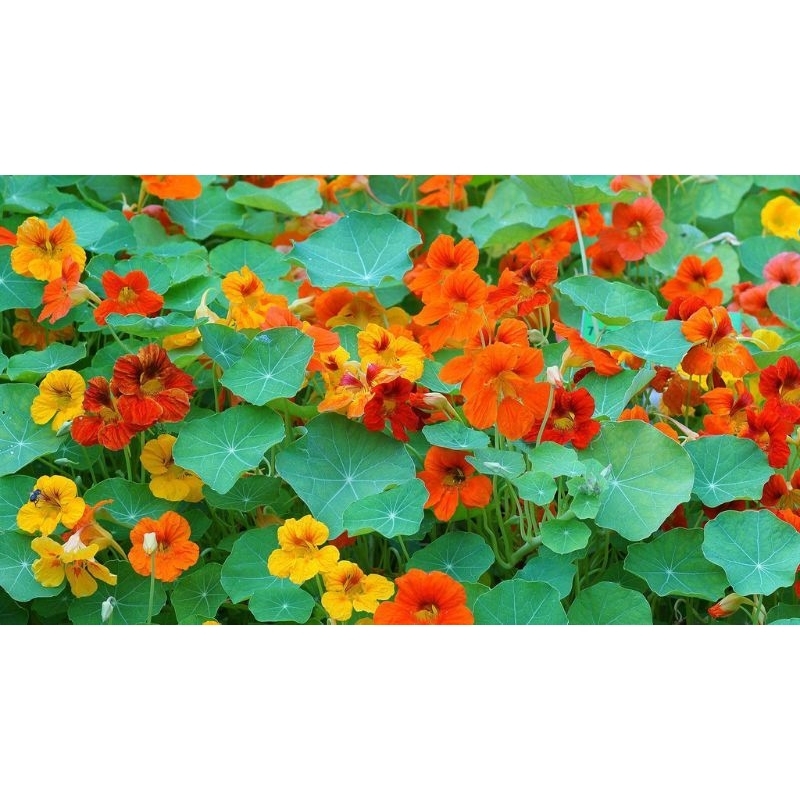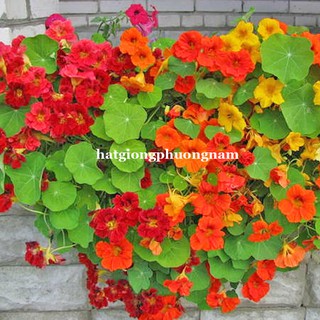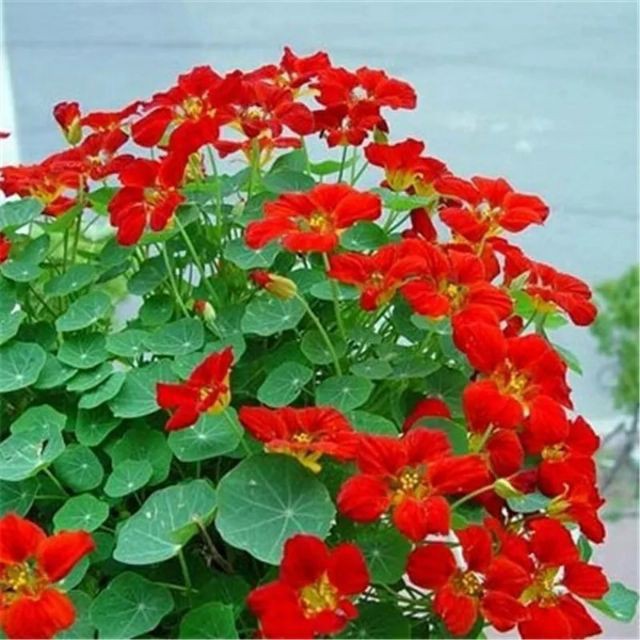Nasturtiums are a versatile, vibrant, and highly beneficial addition to any backyard garden. Known for their beautiful blooms in shades of orange, yellow, and red, these plants not only add color and charm to your outdoor space but also offer a range of practical uses. From natural pest control to attracting pollinators, nasturtiums are an easy-to-grow, edible plant that brings value to gardens of all sizes. Let’s explore why nasturtiums are a must-have and how you can use every part of this remarkable plant.
Benefits of Growing Nasturtiums in Your Backyard
1. Pest Control: A Natural Solution for Garden Health
Nasturtiums act as a “trap crop,” meaning they attract pests like aphids, caterpillars, and whiteflies, diverting these harmful insects away from your more delicate plants. This makes nasturtiums an excellent companion for vegetables like tomatoes, cucumbers, and peppers. By planting nasturtiums nearby, you’re creating a natural defense system in your garden, reducing the need for chemical pesticides.
2. Attracts Pollinators: A Boost for Garden Productivity
Nasturtiums are loved by bees, butterflies, and beneficial insects due to their bright, eye-catching flowers. Pollinators are essential for the reproduction of many plants, including fruits and vegetables. By attracting these helpful creatures to your garden, nasturtiums contribute to better pollination and, consequently, increased yields from plants like squash, zucchini, and berries.
3. Easy to Grow: Low-Maintenance and Resilient
One of the greatest things about nasturtiums is their resilience and ability to thrive in poor soil conditions. In fact, they often do better in low-nutrient soil where other plants might struggle. This makes them a fantastic choice for gardeners seeking low-maintenance plants. Nasturtiums are drought-tolerant and grow quickly, spreading through your garden with minimal effort. They require only occasional watering and will even flourish in container gardens or hanging baskets.
4. Edible and Delicious: A Unique Ingredient for Creative Cooking
Every part of the nasturtium plant—flowers, leaves, and seeds—is edible, adding a unique, peppery flavor that can enhance a variety of dishes. The flowers, with their bright colors and delicate texture, are perfect for salads, while the leaves can be used in a range of savory applications. The seeds, when pickled, make a flavorful substitute for capers. This makes nasturtiums an ideal choice for gardeners who enjoy experimenting with fresh ingredients in their cooking.
How to Use Every Part of the Nasturtium Plant
Each part of the nasturtium plant has its own unique taste and culinary application. Here’s a guide to incorporating nasturtium flowers, leaves, and seeds into your meals.
1. Flowers
Taste: The flowers have a mild peppery flavor, similar to arugula, which adds a refreshing bite to dishes.
How to Use:
Add flowers to salads for a pop of color and spice.
Use as a garnish for appetizers, soups, and main dishes.
Stuff the flowers with soft cheeses like goat cheese or ricotta for a visually stunning and flavorful appetizer.
2. Leaves
Taste: Nasturtium leaves are spicy and peppery, making them perfect for enhancing savory dishes.
How to Use:
Use fresh leaves in salads, sandwiches, and wraps to add a zesty bite.
Blend the leaves into pesto, adding an extra peppery kick that pairs well with pasta or grilled vegetables.
Mix them into omelets or frittatas for an herbaceous, slightly spicy flavor.
3. Seeds
Taste: The green seeds are tangy, with a taste similar to capers.
How to Use:
Pickle the unripe seeds to create “poor man’s capers” for use in salads, sauces, or as a condiment.
Add the seeds to marinades for meats or vegetables for an extra layer of flavor.
Grind the dried seeds and use them as a peppery spice to season roasted vegetables or dressings.
Growing and Caring for Nasturtiums
Planting
When to Plant: Plant nasturtium seeds in the spring after the last frost, or start them indoors a few weeks earlier to get a jumpstart on the growing season.
Soil: They do best in poor or well-draining soil, as high nutrient levels can lead to excessive foliage and fewer flowers.
Sunlight: While nasturtiums can tolerate some shade, they prefer full sun for optimal growth and flower production.
Watering
Frequency: Nasturtiums are drought-tolerant once established, so water them sparingly. Overwatering can lead to root rot, so ensure the soil is slightly dry before watering again.
Maintenance
Pruning: Prune the plants lightly to control growth and encourage bushier plants with more flowers. Remove spent flowers to encourage further blooming.
Pests and Disease: Nasturtiums are generally pest-resistant; however, they may attract aphids. If aphids become a problem, simply spray the plant with a strong stream of water to dislodge them.
Harvesting
Flowers: Pick the flowers when they are fully open but still fresh. The flowers are best used immediately but can be stored in the fridge for a day or two.
Leaves: Harvest young leaves for a milder flavor. Leaves can be used immediately or stored in the fridge for up to a week.
Seeds: Harvest green seeds while they’re still tender, or allow them to dry on the plant if you plan to use them as a spice.
Health Benefits of Nasturtiums
In addition to their culinary uses, nasturtiums have several health benefits:
High in Vitamin C: Nasturtium leaves and flowers are rich in vitamin C, which can support immune health and help fight infections.
Antioxidant Properties: Nasturtiums contain antioxidants that protect against cell damage and support overall health.
Antibacterial and Antifungal: The plant has natural antibacterial and antifungal properties, making it a great natural remedy in folk medicine.
Rich in Nutrients: Nasturtiums also contain iron, calcium, and other trace minerals that contribute to overall wellness.
Creative Ways to Use Nasturtiums Beyond the Garden
Aside from being a vibrant addition to your garden, nasturtiums have some fun and practical uses around the home:
Natural Dyes: The flowers can be used to make natural dyes for fabrics, adding a gentle color to clothing or linens.
Floral Arrangements: Nasturtiums’ colorful blooms make them ideal for bouquets and floral arrangements, brightening any room.
Herbal Infusions: Use the flowers or leaves to create herbal infusions, teas, or even homemade vinegar infusions for a unique flavor twist.
News
Liam Payne’s murder case takes a shocking turn as Argentine police uncover ‘suspicious evidence’ in trash bags at the Buenos Aires hotel.
The shocking news surrounding the death of Liam Payne has taken a dramatic turn as Argentinian police raided the hotel where the singer was staying in Buenos Aires. This development comes as part of a broader investigation aimed at uncovering…
Strictly Come Dancing faces thousands of complaints from viewers after perceived ‘unfair scoring’ for the couple Wynne Evans and Katya Jones: ‘Aside from the scandal, did that awful performance deserve high scores?’
The popular dance competition show “Strictly Come Dancing” has recently found itself at the center of a heated controversy, as accusations of favoritism among the judges have emerged. Viewers and fans alike have raised concerns that certain couples are receiving…
Pete Wicks admits to feeling fearful of Wynne Evans in Strictly after his Halloween transformation revealed all his ‘quirky aspects.’
As Halloween approaches, the excitement in the air is palpable, especially among the stars of various reality and entertainment shows. This year’s festivities have taken on a unique flair, with personalities like Pete Wicks and Wynne Evans sharing some intriguing…
NO STOPPING NOW: Amanda Abbington continues to “fuel the fire” in her dispute with Giovanni Pernice, revealing a critical piece of evidence.
In the vibrant world of competitive dance, the stage is often set for fierce rivalries and unexpected friendships. Recently, Amanda Abbington, a talented actress known for her roles in popular television series, made headlines with her resolute stance regarding her…
Mike Tindall, Princess Anne’s son-in-law, teased an “uncut” podcast episode with Prince William and Kate, saying, “Their real personalities will shock people!”
In a recent discussion, Mike Tindall, the former rugby star and husband to Zara Tindall, made headlines by suggesting that an unedited version of the podcast interview featuring Kate Middleton and Prince William would have left the public in awe….
Buenos Aires police raided CasaSur Palermo Hotel, seizing all staff electronics after discovering links to “drug trafficking” involving Liam Payne.
In the aftermath of Liam Payne’s unexpected death, investigators have turned their attention to a seemingly innocuous item found in his hotel room: a Dove soap box. This unexpected focus on a common personal care product raises numerous questions about…
End of content
No more pages to load














